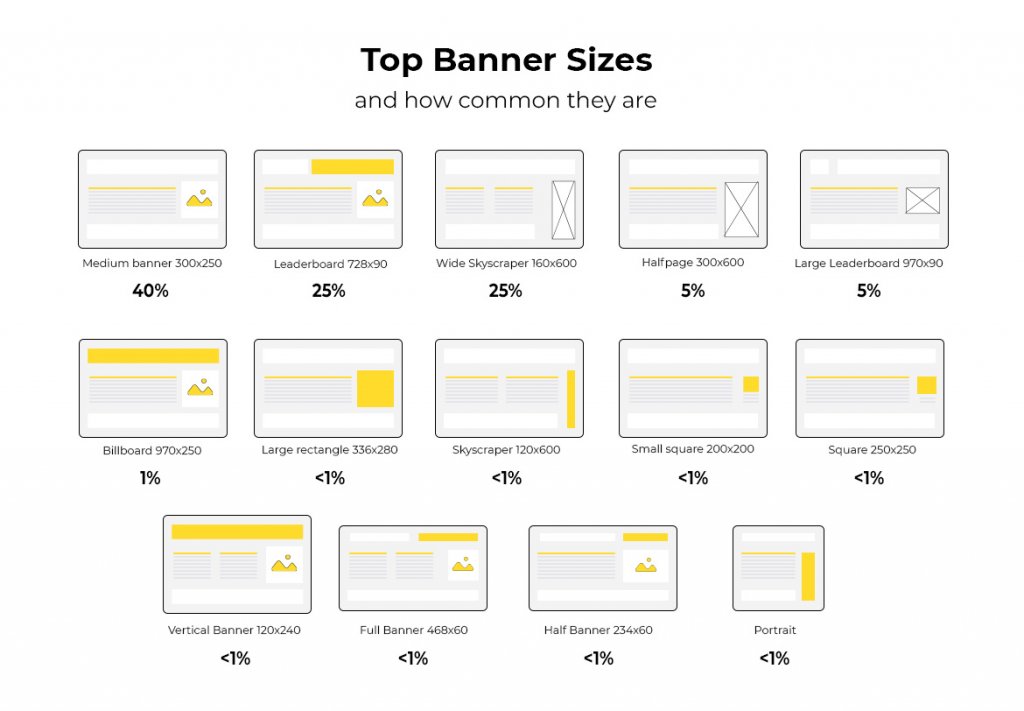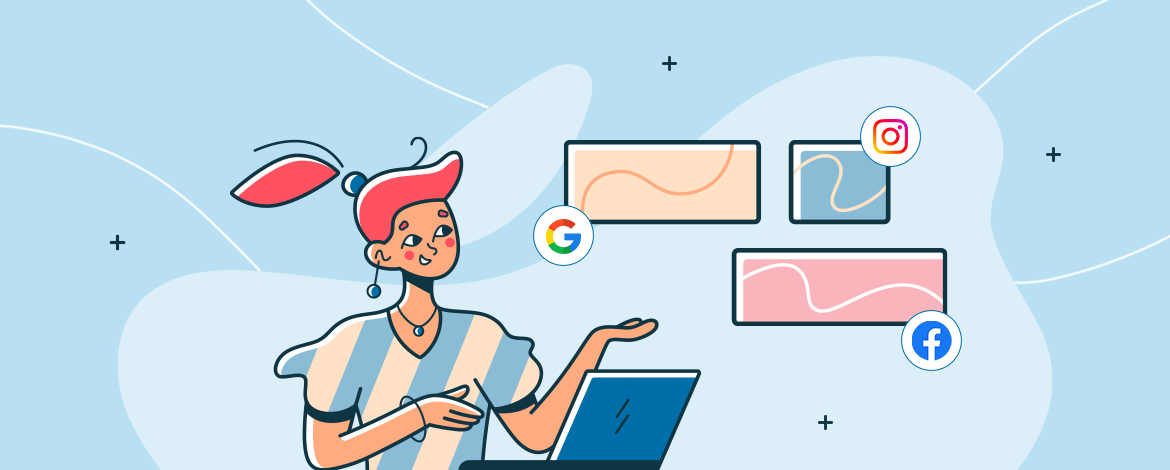Banner ads are one of the most effective advertising channels. If done right, it can draw your prospect’s attention and encourage them to take the required action. Banner advertising is an expensive affair so it becomes all the more important to follow the best practices and other specifications as per the medium you are targeting. Your banners should be such that they can beat banner blindness and generate conversions for your business.
In banner advertising, marketers use rectangular images to display ads. The format of your ad can either be plain text, image, or a combination of text and visuals. Most businesses prefer visually rich banner ads.
Advantages of Banner Ads
- Banners are the oldest form of advertisement. So, they connect instantly with the readers.
- They are more cost effective when compared to TV ads, hoardings, or newspaper ads as they get you quick conversions for your business.
- As they are more likely to get noticed, people will remember the offer even if they don’t act on it immediately.
- You have the liberty to use attractive visuals in your banners. That helps demonstrate the usage of your products and appeal to a larger audience.
- You can showcase the banners on different websites and platforms. As a result, it builds your brand reputation.
- You can get in touch with an agency like Email Uplers who can design banners according to your requirements. Whether you are looking for animated HTML5 banners or simple designs, they have got you covered.
Now, how will you create banners that help you achieve all these objectives?
The answer lies in, apart from several other factors, choosing the correct size according to the platform you are targeting.
Through this article, we shall discuss the ideal banner sizes for Google ads, Facebook ads, and Instagram ads.
We shall start with Google ads.
Google Ads Banner sizes
Google Ads provides a scaffold to draw the user’s attention across the Google Display Network’s 2 million websites and apps. It helps you reach 90% of Internet users around the globe.
You get a number of options to design customized and responsive display ads in different sizes.
Here’s an image showing the top banner sizes and how often they are used.

The commonly used sizes for Google ad banners are:
- Small square (200×200)
As the ad offers limited space, it often ends up being cluttered with text and visual elements. It is hardly used for the same reason.
- Square (250×250)
Businesses avoid it because it is smaller and does not accommodate too much information.
- Banner (468×60)
Just like the previous two, this banner also has a space crunch. It is placed above the navigation bar or between the main content.
- Leaderboard (728×90)
Popularly used by several businesses, the leaderboard ad format stands out and catches the reader’s attention like a shot. It is seen above the navigation bar, particularly in forums.
- Inline Rectangle (300×250)
If you want to reach a huge audience, an inline rectangle or medium rectangle is a great option. When placed in the sidebar and between organic content, it works wonders for the businesses.
- Large Rectangle (336×280)
The large rectangle banner ads are most effective when placed in sidebars and main content. It is commonly preferred because it is likely to get noticed and accommodates all the necessary elements.
- Skyscraper (120×600)
If you want to show downward descending imagery, skyscraper banner ads are a great pick. You can easily find room for this banner ad because of its narrow width design.
- Wide Skyscraper (160×600)
The wide skyscraper is more visible when compared to the simple skyscraper. Choose this banner size when you want to leave a profound impact on your reader’s mind.
- Half-page Ad (300×600)
This banner covers almost half of the web page. So it is more engaging for the readers.
- Large leaderboard (970×90)
As the name suggests, it is bigger than the standard leaderboard banner. Thus, it is more visible and has a better engagement rate.
Note that the file size for all these ads is 150kb.
Facebook Ad Sizes
You cannot rely much on the organic reach of Facebook posts due to the complex algorithms. As a result, you ought to invest in Facebook ads if you want to reach more people. You must determine the size of the Facebook ad according to your business type and the objective you wish to achieve.
Take a look at the commonly used ad sizes for Facebook.
- Facebook Feed Image Ads (1200×628)
Facebook feed image ads are the simplest to create. You can accommodate a lot of information along with rich media in these ads. The maximum file size is 30 MB with aspect ratio tolerance of 3%.
- Facebook Feed Video Ads (600×315 or 600×600)
With the increasing popularity of Instagram reels, TikTok, and YouTube, video content has gained momentum even in the field of advertising. Facebook feed video ads are similar to the image ads but they use videos and are smaller in size. It supports Mp4, MOV, or GIF format up to 4 GB size. It is advisable to add video captions and sound to make your ad more impactful. You can keep the duration up to 241 minutes. The maximum file size is 4 MB for videos. The aspect ratio tolerance is 3%.
- Facebook Carousel Ads (1080×1080)
If you ask me, I personally like Facebook carousel ads the most. I will tell you why. It allows you to display a huge range of products in a single ad. The reader can swipe through to see what the business has to offer. You can have 2 to 10 carousel cards in the ad. The maximum file size for images is 30 MB and 4 MB for videos. The video duration is 1 second to 240 minutes with aspect ratio tolerance of 3%.
- Facebook Right Column Ads (1200×628)
Facebook right column ads have gotten less popular as they are compatible with desktop only. As most users access Facebook through mobile devices, it has become pointless to invest in these ads.
- Facebook Marketplace Ads (1200×628)
Facebook gives a feature of buying and selling things through its Marketplace. If you are using Facebook to sell things, you can feature your ad in the Facebook marketplace.
- Facebook Instant Articles Ads (1200×628)
Content marketers and media publishers can use Facebook instant articles ads for content distribution. It is visible on mobile and messenger apps. You can either use images or videos in these ads.
- Facebook Stories Ads (1080×1920)
A combination of still images and short videos makes Facebook stories ads a versatile advertising option. It will display the images for 5 seconds and videos for up to 15 seconds.
- Facebook Collection Ads (600×600)
Imagine being able to promote a product catalog through Facebook…
That’s exactly what Facebook collection ads are all about. On clicking, users will be redirected to an instantly loading visual catalog. And you know the best part? You don’t need to leave Facebook to access it. The only requirement is Instant Experience that imparts a full-screen experience to users who tap your ad on a mobile device.
Instagram Ads
Instagram is among the most powerful platforms for advertising. It gives you an opportunity to reach the huge user base of 1.386 billion customers through the ads. If you want to target this 4th most popular social network correctly, make sure you follow all the best practices related to the ad sizes.
The most commonly used sizes are:
- Instagram Single Image Ads (400×500)
Maximum users prefer Instagram single image ads. It is displayed on the full screen for the user.
- Instagram Video Ads (400×500)
Instagram video ads allow you to create videos in landscape, square, or vertical mode. It is similar to Instagram image ads.
- Instagram Carousel Ads (1080×1080)
You can use up to ten images or videos in Instagram carousel ads. eCommerce websites can showcase their wide variety of products through this ad format.
- Instagram Stories Carousel Ads (1080×1920 and 1080×1080)
There are two types of carousel ads: Native stories carousel and expandable stories carousel. The aspect ratio for native stories’ carousels is 9:16 while for expandable stories’ carousels is 1:1. It supports MP4 and MOV formats under 4 GB. The maximum length for these ads is 15 seconds.
- Instagram Slideshow Ads (600×600, maximum 1080×1080)
Slideshow Ads allow the usage of up to 10 images looped in a video. You can even add the musical track you like, provided you have the legal right to use it.
- Instagram Stories Image Ads (1080×1920)
Instagram stories image ads help display a full-screen ad for 5 seconds or unless the user swipes out of it.
- Instagram Stories Video Ads (1080×1920)
Besides images, you can add sound to Instagram stories video ads. Just like image ads, they are full-screen vertical ads that users can view for 120 seconds.
Wrapping Up
Banner advertising is a bit technically challenging as you need to consider several points like file size and its format. It would certainly help to bookmark this article and go through it every time you plan to create ads for Google, Instagram, and Facebook.
If you need any help with creating your banner ads, help is just a click away with Email Uplers.




Disha Bhatt (Dave)
Latest posts by Disha Bhatt (Dave) (see all)
Data Hygiene: Why It Is The Key To Ensuring Your Email Campaign's Success (And How To Achieve It)
Guide to Creating Great Confirmation Emails that Acknowledge, Impress, and Delight